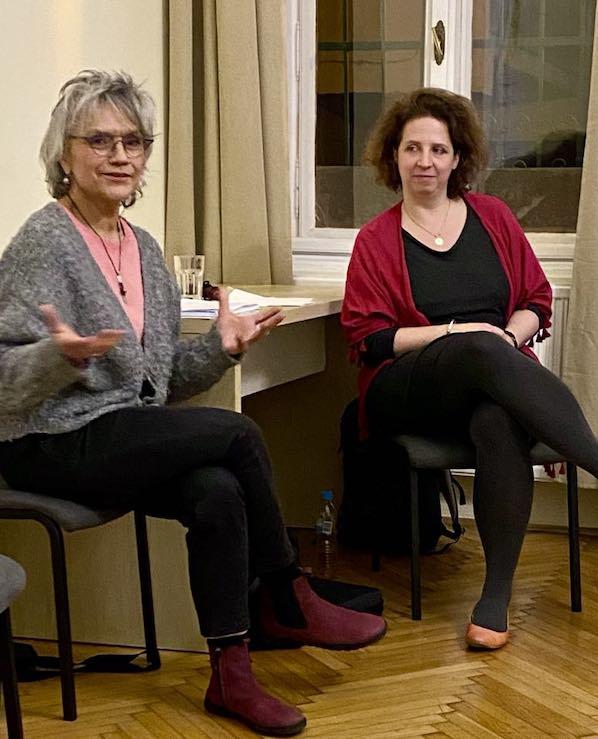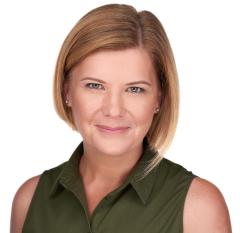On a special evening in late February in Budapest, participants gathered not just for another lecture, but for an experience. The event was open to anyone interested in Focusing, whether they were newcomers or long-time practitioners. Astrid Schillings, a Focusing Coordinator and psychotherapist, was the invited guest, and what unfolded over the next two hours became much more than a talk. It was, in itself, a living demonstration of Focusing, particularly the deeply embodied approach she calls "Focusing with the Whole Body – The Bodying Person.”
The evening was moderated by Gerda Zimmermann, a local Focusing trainer, who began the event by acknowledging the support of the Hungarian Institute for Focusing and Focusing-Oriented Psychotherapy (HIFFOP), as well as the community space that kindly hosted the gathering for the second time. Though the Facebook invitation had reached over 40 people, no one could predict exactly how many would show up—which seemed fitting, as uncertainty and openness to the moment are at the heart of Focusing practice.
A Life Devoted to Focusing
Astrid began by introducing herself not through titles or accolades, but through her personal connection to the practice. She first encountered Focusing in 1981 as a psychology student at Bonn University, through Eugene Gendlin’s highly influential paper, The Theory of Personality Change. The ideas in the paper resonated so deeply with her that, as she described it, “Focusing bit me, and it never let go.”
This led her to travel to the Focusing Institute in Chicago, where she trained under Eugene Gendlin, as well as Mary McGuire and Janet Klein - the originators of Interactive Focusing. Gendlin himself became a central influence in her development. More than a therapeutic technique, Astrid described Focusing as a philosophical life practice—a way of being with experience, grounded in Being-Here, inner listening, and the letting come of meaning from the felt experiencing within. Psychotherapy is only one of many applications.
The Whole Body Knows
While traditional Focusing is often practiced while sitting, going back and forth between talking, silence, listening and saying back, Astrid has developed her own unique and dynamic approach: Focusing with the Whole Body. Inspired and encouraged by Kevin McEvenue and his work with Wholebody Focusing, Astrid continued her own path towards the Bodying Person.
She explained how, during her early training, she realized that her natural expressiveness—talking with her hands, moving her body—seemed out of place in both academic and therapeutic settings. But Gendlin noticed and encouraged it.
He said,
“Can you listen into your hands? They know something.”
This invitation opened a door.
Astrid began to explore how gestures, body posture, and movement could be part of the Focusing process. Not as distractions or side effects, but as meaningful explications of the felt sense. Over time, she developed the Bodying Process Language where gesture, posture and movement become both the entry point and the unfolding path of felt sensing awareness.
In this way, the living body itself becomes the guide; not just something we observe, but something we are in relationship with. A movement, like a hand reaching or a head turning, might hold as much symbolic meaning as a word. And just like with words in Focusing, we can pause and sense whether that movement “feels right”—whether it fits something deeper within.
Focusing as a Lived Conversation
One of the most moving parts of the evening was not just what Astrid shared, but how she shared it.
Rather than delivering a fixed presentation, she lived the process in real time. Her words didn’t come in a rush. She paused often, sometimes closing her eyes, letting her body speak first. Then the next sentence would arrive—not from her head, but from something deeper, more grounded.
The audience found themselves naturally slowing down with her. It felt as though we were inside a Focusing session together, simply by listening. The rhythm of her voice, the reflective pauses, the subtle shifts in tone and posture—all invited a quality of shared presence.
This was Focusing, not only in content but in form.
A Taste of the Practice
To give participants a felt sense of what Focusing means, Astrid guided a brief experiential exercise:
- Write down a landscape you love—without overthinking. Just let the words come.
- Sense into your body. How does this landscape resonate in your bodylife? What physical sensations or emotions come?
- Notice if a gesture or movement wants to come—a stretch, a sigh, a moving hand.
- Be with what arises—not to change it, but to keep it company.
One participant shared their experience of sensing a small lake inside with streams flowing in multiple directions, both downward and upward. Another described the surprising emergence of a “falling” feeling. These bodily resonances—unexpected, moving, often hard to put into words—are at the heart of Focusing.
Astrid emphasized that we don’t need to explain or interpret these inner sensations right away. Simply acknowledging and being with them can bring about a shift. This gentle allowing and the qualities of being-with are especially vital in trauma work, where experiences of isolation or overwhelm can subtly and slowly be shifted by the felt sense of being in company - body life to body life.
Making Space for the Movement
Astrid also spoke to the challenge of integrating movement into Focusing. Our cultures don’t always support bodily expression, especially in reflective settings. Movements often pass quickly, or may feel too private. That’s why Astrid has worked to develop a language and an atmosphere where movement can be invited, trusted, and explored—just like words.
She explained:
“Sometimes a movement expresses more than a word. And sometimes, the movement brings the shift we were waiting for.”
She also acknowledged that for some people, following a movement can feel like losing contact with the inner experience. But when grounded in the felt sense—when movement arises from the sensing, rather than replacing it—it can deepen the process rather than distract from it.
Beyond Therapy: Art, Ecology, and Everyday Life
Astrid’s work doesn’t stop at therapy. She shared how artists use Focusing with movement to find the next stroke in a painting. How activists draw strength from grounding into being- here, sensing the body living from itself in moments of overwhelm. And how she herself might have become an artist if not a therapist—indeed, she continues to take photographs, write, and spend time in nature as forms of personal nourishment.
She also spoke about her deep connection to ecological concerns, seeing Focusing as a practice that supports our relationship not only with ourselves but with the world. For her, the body is not isolated, we are not isolated—we are the ongoing interaction with the environment, constantly shaping and shaped by it.
Final Grounding and Gift
As the evening drew to a close, Astrid offered a grounding practice, inviting participants to gently shift their weight, feel how their feet were connecting to the ground, sense the aliveness in their spine, and how it wants to breathe. It was a quiet return to presence before flying home, literally or metaphorically.
In appreciation, the organizers offered her a small piece of Hungarian handmade jewelry—magenta, warm-toned, and perfectly suited to her vibrant yet grounded presence.
Conclusion
Astrid Schillings offers us more than a method—she offers a way of being. Through her Focusing with the Whole Body approach, she reminds us that meaning doesn't just live in words, it lives in gestures, breath, posture, stillness. In pausing, in sensing, in trusting the body to speak in its own language.
In her presence, we didn’t just learn about Focusing, we experienced it. We felt how inner listening can become a shared field, how a conversation can unfold like a Focusing process, and how even a small movement might carry the wisdom of something waiting to be known.
Focusing is not only a practice—it is a way of living from what is deeply, quietly true.
Krisztina Svéd is a Certified Focusing Professional, Focusing Trainer and Focusing-Oriented Therapist. She integrates Focusing into her work as a mental health counselor and trainer, helping individuals explore their inner resources and develop personal growth. Krisztina is also a PhD researcher at Corvinus University of Budapest in Hungary, specializing in organizational wellbeing.


